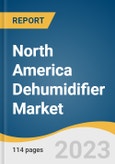According to the U.S. Census, in 2021, the U.S. annual value of put-in residential construction including renovations increased by 20% and reached USD 802.93 billion. Furthermore, non-residential building investment in 2021 reached USD 823.51 billion. The demand for housing including multifamily and single-family residential buildings is expected to witness significant growth in the region by 2030. The above mention factors will positively impact the North America portable dehumidifier market’s growth.
The rising awareness among consumers about the benefits of humidity control for asthma patients is anticipated to augment the demand for refrigerative dehumidifiers in North America over the forecast period. These are the most common dehumidifiers used in basements, kitchens, storage rooms, bathrooms, and bedrooms in households. They are also used in commercial spaces such as indoor spas, swimming pools, sports centers, recreational centers, galleries, and museums wherein the damp environment may lead to the growth of mold.
Growing awareness among consumers about the high operational efficiency of electronic/heat pump dehumidifiers is anticipated to fuel their demand in the coming years. Moreover, an increase in innovations and research and development activities for launching suitable electronic/heat pump dehumidifiers with a desired relative humidity that can operate in different temperatures is also fueling the growth of this segment of the market.
Increasing investments in water and wastewater treatment plants are also anticipated to augment the growth of the regional dehumidifier market over the forecast period. Wastewater treatment plants face problems of corrosion due to the condensation of water droplets on the metal parts, which requires dehumidifiers to reduce moisture content. There are several new plants under construction across North America. For instance, in 2021, the U.S. government announced the construction of the largest water and sewage projects including the Houma Navigation Canal Lock Complex and Stormwater Treatment Area 1 West Expansion.
The North America dehumidifier industry is highly competitive owing to the presence of both multinational and local manufacturers. Most players concentrate on several factors including regional expansion, distribution, partnerships, strategic acquisition, and major deals. For instance, In September 2021, LG Electronics, Inc. launched an upgraded version of the PuriCare Wearable Air Purifier to provide an enhanced capability dehumidifier for homes.
North America Dehumidifier Market Report Highlights
- The desiccant dehumidifier segment dominated the market in 2023, accounting for 56.5% of the revenue share.
- The industrial segment accounted for 44.6% of the market share in 2023. The demand for dehumidifiers for industrial applications is rising due to the need for precise humidity control in sectors like pharmaceuticals and food and beverage.
- In 2024, the fixed segment represented 56.7% of the market revenue. Growth in water and wastewater treatment plants is also anticipated to augment the market growth over the projected period.
- The U.S. dehumidifier market is expected to hold 88.0% of the North America market in 2024, owing to increasing population and rising disposable incomes, along with improving urbanization, which is expected to augment the food & beverage industry’s growth in the U.S.
Why should you buy this report?
- Comprehensive Market Analysis: Gain detailed insights into the global market across major regions and segments
- Competitive Landscape: Explore the market presence of key players worldwide
- Future Trends: Discover the pivotal trends and drivers shaping the future of the global market
- Actionable Recommendations: Utilize insights to uncover new revenue streams and guide strategic business decisions
This report addresses:
- Market intelligence to enable effective decision-making
- Market estimates and forecasts from 2018 to 2030
- Growth opportunities and trend analyses
- Segment and regional revenue forecasts for market assessment
- Competition strategy and market share analysis
- Product innovation listing for you to stay ahead of the curve
- COVID-19's impact and how to sustain in these fast-evolving markets
The leading players in the North America Dehumidifier market include:
- LG Electronics Inc.
- Honeywell International Inc.
- GE Appliances, a Haier Company
- De’Longhi Appliances S.r.l.
- Bry-Air Inc.
- Danby Products Ltd
- Whirlpool Corporation
- Munters Group
- STULZ Air Technology Systems, Inc.
- CondAir Group
Table of Contents
Companies Mentioned
- LG Electronics Inc.
- Honeywell International Inc.
- GE Appliances, a Haier Company
- De’Longhi Appliances S.r.l.
- Bry-Air Inc.
- Danby Products Ltd
- Whirlpool Corporation
- Munters Group
- STULZ Air Technology Systems, Inc.
- CondAir Group
Methodology

LOADING...
Table Information
| Report Attribute | Details |
|---|---|
| No. of Pages | 114 |
| Published | October 2024 |
| Forecast Period | 2024 - 2030 |
| Estimated Market Value ( USD | $ 1.23 Billion |
| Forecasted Market Value ( USD | $ 1.86 Billion |
| Compound Annual Growth Rate | 7.3% |
| Regions Covered | North America |
| No. of Companies Mentioned | 10 |









